

Messier 10. Messier 10 or M10 (also designated NGC 6254) is a globular cluster of stars in the equatorial constellation of Ophiuchus.
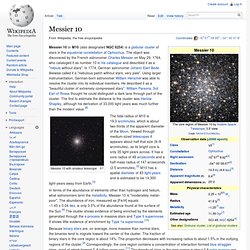
The object was discovered by the French astronomer Charles Messier on May 29, 1764, who cataloged it as number 10 in his catalogue and described it as a "nebula without stars". In 1774, German astronomer Johann Elert Bode likewise called it a "nebulous patch without stars; very pale". Using larger instrumentation, German-born astronomer William Herschel was able to resolve the cluster into its individual members.
Messier 12. Messier 12 or M 12 (also designated NGC 6218) is a globular cluster in the constellation of Ophiuchus.
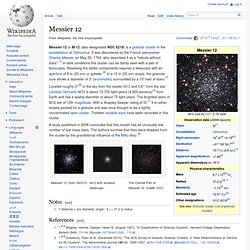
It was discovered by the French astronomer Charles Messier on May 30, 1764, who described it as a "nebula without stars".[7] In dark conditions this cluster can be faintly seen with a pair of binoculars. Resolving the stellar components requires a telescope with an aperture of 8 in (20 cm) or greater.[8] In a 10 in (25 cm) scope, the granular core shows a diameter of 3′ (arcminutes) surrounded by a 10′ halo of stars.[7] Located roughly 3°[8] in the sky from the cluster M10 and 5.6° from the star Lambda Ophiuchi, M12 is about 15,700 light-years (4,800 parsecs)[3] from Earth and has a spatial diameter of about 75 light-years. Messier 14. Messier 14 (also known as M14 or NGC 6402) is a globular cluster in the constellation Ophiuchus.
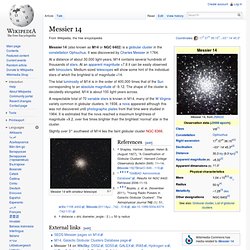
It was discovered by Charles Messier in 1764. At a distance of about 30,000 light-years, M14 contains several hundreds of thousands of stars. At an apparent magnitude +7.6 it can be easily observed with binoculars. Messier 19. Messier 19 or M19 (also designated NGC 6273) is a globular cluster in the constellation Ophiuchus.
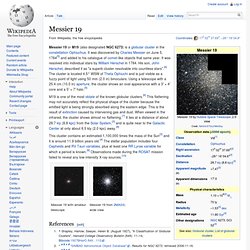
It was discovered by Charles Messier on June 5, 1764[5] and added to his catalogue of comet-like objects that same year. It was resolved into individual stars by William Herschel in 1784. His son, John Herschel, described it as "a superb cluster resolvable into countless stars".[6] The cluster is located 4.5° WSW of Theta Ophiuchi and is just visible as a fuzzy point of light using 50 mm (2.0 in) binoculars. Using a telescope with a 25.4 cm (10.0 in) aperture, the cluster shows an oval appearance with a 3′ × 4′ core and a 5′ × 7′ halo.[5] This cluster contains an estimated 1,100,000 times the mass of the Sun[3] and it is around 11.9 billion years old.[4] The stellar population includes four Cepheids and RV Tauri variables, plus at least one RR Lyrae variable for which a period is known.[9] Observations made during the ROSAT mission failed to reveal any low-intensity X-ray sources.[10] Messier 62.
Messier 62 (also known as M62 or NGC 6266) is a globular cluster in the constellation Ophiuchus.
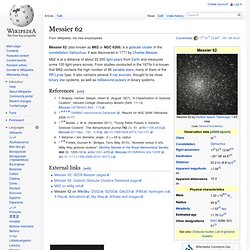
It was discovered in 1771 by Charles Messier. M62 is at a distance of about 22,500 light-years from Earth and measures some 100 light-years across. From studies conducted in the 1970s it is known that M62 contains the high number of 89 variable stars, many of them of the RR Lyrae type. It also contains several X-ray sources, thought to be close binary star systems, as well as millisecond pulsars in binary systems. References[edit] Jump up ^ Shapley, Harlow; Sawyer, Helen B.
Messier 107. Globular Cluster M107 (also known as Messier Object 107 or NGC 6171) is the last globular cluster in the Messier Catalogue.
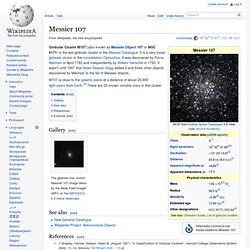
It is a very loose globular cluster in the constellation Ophiuchus. It was discovered by Pierre Méchain in April 1782 and independently by William Herschel in 1793. It wasn't until 1947 that Helen Sawyer Hogg added it and three other objects discovered by Méchain to the list of Messier objects. M107 is close to the galactic plane at a distance of about 20,900 light-years from Earth.[3] There are 25 known variable stars in this cluster. Gallery[edit] See also[edit] References[edit] Jump up ^ Shapley, Harlow; Sawyer, Helen B. External links[edit] Coordinates: Ophiuchus_IAU. Ophiuchus. Ophiuchus /ɒfiˈjuːkəs/ is a large constellation located around the celestial equator.

Its name is from the Greek Ὀφιοῦχος "serpent-bearer", and it is commonly represented as a man grasping the snake that is represented by the constellation Serpens. Ophiuchus was one of the 48 constellations listed by the 2nd-century astronomer Ptolemy, and it remains one of the 88 modern constellations. It was formerly referred to as Serpentarius /sɜrpənˈtɛəriəs/ and Anguitenens. Location[edit] Ophiuchus straddles the equator but lies predominately to its north. In contrast to Orion, it is in the period November–January (summer in the Southern Hemisphere, winter in the Northern Hemisphere) when Ophiuchus is in the daytime sky and thus not visible at most latitudes.
Ophiuchus. Messier 9. Messier 9 or M9 (also designated NGC 6333) is a globular cluster in the constellation of Ophiuchus.
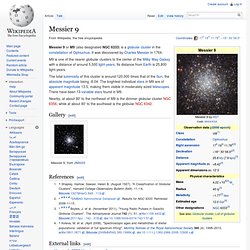
It was discovered by Charles Messier in 1764. M9 is one of the nearer globular clusters to the center of the Milky Way Galaxy with a distance of around 5,500 light-years. Its distance from Earth is 25,800 light-years. The total luminosity of this cluster is around 120,000 times that of the Sun, the absolute magnitude being -8.04. The brightest individual stars in M9 are of apparent magnitude 13.5, making them visible in moderately sized telescopes. Nearby, at about 80' to the northeast of M9 is the dimmer globular cluster NGC 6356, while at about 80' to the southeast is the globular NGC 6342. Gallery[edit] References[edit] Jump up ^ Shapley, Harlow; Sawyer, Helen B. External links[edit] Coordinates: